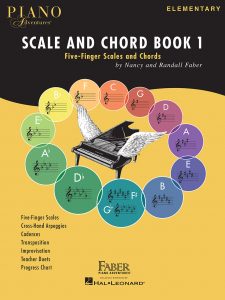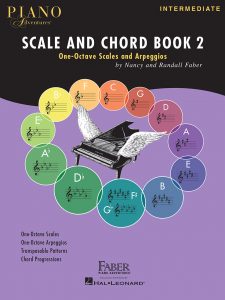
3-D Gesture and Precision Pattern Recognition Reveal a Unique Path to Musical Proficiency
Ann Arbor, MI – July 12, 2016 – With the new Piano Adventures Scale and Chord Books 1 and 2, Nancy and Randall Faber directly address the obsolete tradition of mindless drilling and instead encourage a lucid grasp of scale and chord practice. The series focuses on optimal pattern recognition by assigning meaning to each scale degree – fundamental to revealing melodic direction and harmonic intent. Through variations and specific transpositions among keys, students can now become truly proficient in the language of music. And, through alignment of the wrist and arm with each finger, students build a foundation of real virtuosity.
 For generations, piano study has been associated with hours of tedious scale practice. Repetition of fingerwork up and down the keyboard was thought to develop finger strength and thus a proficient technique. The Fabers advocate for a more three dimensional approach to piano technique, prescribing technical gestures for efficient and relaxed use of the wrist and body.
For generations, piano study has been associated with hours of tedious scale practice. Repetition of fingerwork up and down the keyboard was thought to develop finger strength and thus a proficient technique. The Fabers advocate for a more three dimensional approach to piano technique, prescribing technical gestures for efficient and relaxed use of the wrist and body.
Scale and Chord Book 1 charts progress through all major and minor five-finger scales, with primary chords and transpositions of little classical pieces in all keys. Teacher duets support each major and minor scale lesson. Imagery and duets inspire student-teacher improvisation. There’s easy classic repertoire for five-finger transposition, plus opportunities to harmonize scale patterns.
 Scale and Chord Book 2 has seven sections for effective sequential presentation of major and minor scales. Variations emphasize the functions of tonic, dominant and leading tone, with exercises and technical tips added for fluency. One-Octave Arpeggios invite 3-dimensional movement and transposable chord progressions engage the ear in a contemporary context.
Scale and Chord Book 2 has seven sections for effective sequential presentation of major and minor scales. Variations emphasize the functions of tonic, dominant and leading tone, with exercises and technical tips added for fluency. One-Octave Arpeggios invite 3-dimensional movement and transposable chord progressions engage the ear in a contemporary context.
Piano Adventures Scale and Chord Books thus reveal a more effective and inviting path than the traditional rehashing of scale fingerings and key signatures. For extended learning and teacher support, future plans include audio and video instruction to supplement the Scale and Chord books. These will be released on the Piano Adventures YouTube Channel and in the Piano Adventures Player App for iPhone and iPad later this year.
About Faber Piano Adventures
Nancy and Randall Faber have combined their backgrounds as composer and performer to become leading supporters of piano teachers and students. The husband and wife team has authored over 300 publications, including the bestselling Piano Adventures method and the PreTime® to BigTime® Piano Supplementary Library. Their innovative and exciting methods continue to enjoy an unprecedented response from teachers and students around the world, setting a new standard for quality educational publications in print, audio and digital formats. Faber Piano Adventures has been translated into seven languages and is distributed by the Hal Leonard Corporation.
5 replies on “Piano Adventures Announces a New Approach to Scale and Chord Practice”
Comments are closed


I have Scale & Chord Book 2. I am learning lots but also have questions.
1. When a student is asked to play the scale of the piece which she is playing and the piece is in D minor, which of the minors on p. 26 is she to play. Natural minor?
2. When are the different minors used. I’m use to just lowering the 3rd finger 1/2 tone and saying that’s the minor. Is that the natural Minor?
3. There must be virtue in how the scales are presented in this book. Looking at p. 24 can you explain why you chose these exercises in this order.
Thanks much.
Good questions, Dorothy!
1. The harmonic minor scale is the most common form, but the whole routine (natural, harmonic, melodic, and primary chords) is a good challenge to play through without stopping. Once mastered, the Mini Etude (hands-together natural, harmonic, and melodic minor, and the “power chords”) provides the next challenging variation. If short on practice time and in need of a quick orientation, play just the harmonic minor scale hands-together, followed by the primary chords.
2. Study how the minor keys are introduced in the Level 3B Lesson Book (for example, A minor on pages 6-7). Natural minor is the _natural_ result of sharing a key signature with a major key. Harmonic minor reinforces the strength of the _harmonic_ progression of dominant (V chord) to tonic (I chord), with the raised leading tone (scale degree 7). Melodic minor is sometimes used to smooth otherwise-awkward gaps in _melody_ between scale degree 6 and 7 (Carol of the Bells is a popular example).
3. In the core method books, the student’s exploration of minor is spread out (Level 2A introduces the sound and feel of minor five-finger scales, Level 3B introduces one-octave minor scales, Level 4 expands to two-octaves, and Level 5 qualifies all three forms of the minor scales). In this spiral curriculum structure, each time a concept is revisited, it is clarified for more precise understanding or amplified for broader application. Compare this to the potential of the Scale and Chord Book series as encyclopedic reference material, and factor in the extreme similarity of fingerings between the three forms of the minor scales, and it is easy to see how grouping the three forms together provides practical organization and a technical workout.
Wow, I just found this. Thanks so much. Back to #1. At Achievement Day the student is to play the scale of the key in which the piece is written. Do I understand you to say that the D harmonic minor should be played. They ask for only one.
I like presenting scales in a book like this rather than spread out in the core books.
Which Piano Adventures levels should these scale books be introduced?
Hi Lisa — Scale and Chord Book 1 is for students in Levels 1, 2A, 2B, Accelerated Piano Adventures and Adult Piano Adventures. Scale and Chord Book 2 is for students in Levels 3A and 3B. We are planning to release Scale and Chord Book 3 in 2017, that will be for students in Levels 4 and 5.